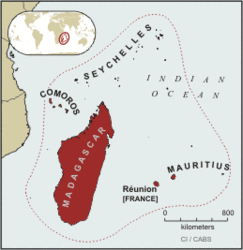4 Things To Know About the Malagasy Language of Madagascar
By Sarah-Claire Jordan
The first thing people think about when they hear the word “Madagascar” is probably something along the lines of a menagerie of animals only found on that particular island of the coast of Africa. However, people do live on that same island, and have lived there for centuries, much like any other country, and with people come culture and language.
The official languages of Madagascar are French and Malagasy, the latter being an Austronesian language spoken as a first language by most citizens of Madagascar. As of 2007, there were about 18 million native speakers of Malagasy. Here are four other tidbits that make Malagasy interesting:
- It is the westernmost Malayo-Polynesian language
The Malayo-Polynesian languages are a branch of languages of the Austronesian language family which includes Indonesian, Maori, Samoan, and more. Of all of the languages in the Malayo-Polynesian branch, Malagasy is the language that is spoken in areas farthest to the west, right next to continental Africa. Malagasy is very closely related to the East Barito languages of Borneo.
- People have been writing in Malagasy since the 15th century
Though the language wasn’t officially discovered to be different from other African languages spoken in areas close by, the oldest written records in Malagasy date back to the 15th century. At first, a script based on an Arabic script used for African language was the one used to write in Malagasy, and these writings were mostly texts about astrology and magic. Later on, a Latin script was introduced with 21 different letters.
- There are two main dialects of Malagasy
Though it is really only spoken on Madagascar and a few neighboring islands, there are still dialects of this language. These dialects are divided into eastern and western, with the main eastern dialect being Merina and the main western dialect Sakalava. The distinguishing features of the Merina dialect are an [ə̥] that is voiceless, the final *t of words becoming [ʈʂə̥], and *li and *ti sounds exchanged for [di]. In Sakalava, final nasal consonants are dropped, the final *t is [tse], and the *li and *ti remain. Some dialects of Malagasy are even considered languages in their own right, but they still retain a great deal of mutual intelligibility.
- There are many types of “these, those, that, etc.” words in Malagasy
These types of words, ones that can’t be totally understood without some context, are called deixis in linguistics. In the case of Malagasy, the words for here, there, this, that, these, and those are particularly complicated. There are actually seven different degrees of distance for these words in Malagasy, plus different degrees of evidentiality, which is essentially whether the thing being referred to by there, here, etc., is visible or not. It all makes for a difficult learning curve for people learning the language.
If that doesn’t convince you that Malagasy is a language worth at least reading about, then there probably isn’t much else that will convince you. As a company, Alpha Omega Translation recognizes the beauty in every language and the importance of providing excellent translation, interpretation, and desktop publishing services in as many languages as possible.
For an overview of our translation expertise, visit our website translation and localization page.
Category: Foreign Language








